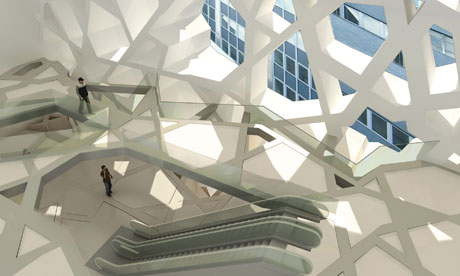 |
| Park51’s white lattice ‘exoskeleton’ is inspired by the elaborately patterned mashrabiyas of Islamic architecture. Photograph: Anonymous/ASSOCIATED PRESS |
As to what it is, the explanation is not at first very enlightening. Park51, to use the project's proper name, is "a friendly and accessible platform" that "enriches lower Manhattan in body and spirit, with ecologically conscious design and operation". However, its architect, Michel Abboud, makes things clearer: it is a Muslim version of the YMCA, or the many Jewish community centres in New York. That is, it will have a swimming pool, basketball court, childcare and exhibition facilities, a library, auditorium, restaurant and catering school.
When built, it will be 16 storeys high, and 10% of its floor area will be a "prayer space". It will be large – big enough for 1,500 people – but there will be no minaret, or room for ablutions, or other essential features of a mosque. Its religious elements would be "a matter of interior design", as Abboud puts it, and faiths and groups other than Muslims will be able to pray there. The project now has planning permission and, subject to fundraising, will be completed, at the earliest, in three years' time.
As Abboud tells it, the year's most controversial building project came about almost by chance, through a sequence of reasonable decisions. It started when the developer Soho Properties bought the former Burlington Coat Factory in Park Avenue, lower Manhattan. It considered potential uses, conducted market research, and found that there was a need for "community facilities" in the area. Sharif El-Gamal, a Muslim American who runs Soho Properties, attended the nearby mosque of Imam Feisal Abdul Rauf, who had been working in the area for 30 years.
Together they decided to create what is now Park51. That the project was close to Ground Zero was due to El-Gamal's and Rauf's long connections with the area. But they were conscious of the significance of the place, and it was not unwelcome to them. Rauf has said that it gave an opportunity to make "the opposite statement" to the destruction of the Twin Towers.
Abboud is a young architect on the rise, who "started building projects before I graduated", and now, at 33, runs Soma Architects, a practice with 30 staff and offices in New York, Mexico and Beirut. Its work so far has consisted mostly of smart restaurants and luxury residential projects – nothing approaching the significance of Park51. He is a walking melting pot, albeit of a somewhat privileged kind, a Catholic of French, Lebanese and Mexican origins.
"The difficulty from day one," he tells me with some understatement, "was to satisfy all the different parties: the developers, the religious institution and the average New Yorker." The building had to promote "integration and unity", and be "porous and open to the city" while "maintaining a landmark quality". He was "not going to fall into stereotypical illusions of what Islamic architecture looks like".
He conceived a "self-supporting exoskeleton", a white lattice that holds the building up, creates shade, and defines the character of the interiors. It is inspired by mashrabiyas, the elaborately patterned sunscreens common in Islamic architecture. He is not, he stresses, the first western architect to have this idea: Jean Nouvel's 1988 Institut du Monde Arabe in Paris, for one, did something similar. The designs of Abboud's lattice are based on "ancient historical patterns that have a very long story to them", but "some people imagined there were reversed Stars of David included as a provocation to Jews". It was "only a few people, and very far-fetched", but he is still responding by making the traditional patterns "more blurred".
The design is "still evolving, but I expect the finished building to have a similar concept". Abboud claims that "every time the project is presented properly, without the media swirl, people respond positively".
Indeed, the idea of the project was in the public domain for six months, following its announcement in the New York Times a year ago, before anyone made a fuss. It was approved unanimously by the local Community Board in May. Only after that, with the US midterm elections looming, was a political storm whipped around it. Abboud believes that slow progress on the 9/11 memorial, which is now due to be dedicated at next year's 10th anniversary, did not help. "Whether consciously or unconsciously, people feared the centre could be built before the Ground Zero memorial was built."
It probably also doesn't help that the project is nuanced and ambiguous. As a 16-storey building for a Muslim group, located where it is, it is clearly a statement of something, but it is not completely explicit what this something is. As well as a community facility, it is a demonstration of Muslim presence in New York, and that most Muslims are not terrorists.
This clearly should not cause anyone a problem, yet in the febrile atmosphere of modern America, ambiguity makes space for baroque fears. "Let 'em build it, then bomb it – at the busiest time of day," was one of the less charming reactions. Abboud says: "It is very important to understand the healing power of architecture." There is an awful lot of healing still to do.
http://www.guardian.co.uk/world/2010/nov/07/ground-zero-park51-new-york